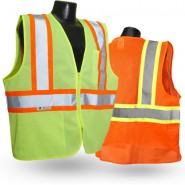
Columbus Fleet Industrial Supply
Canton Fleet Industrial Supply
Canton First Aid & Safety
Phone: (614) 332-7464
Phone: (330) 408-7374
email: sales@cfisgroup.com
|
|
Classes 1, 2 & 3
Class 1
Class 1 safety vests are for workers in low impact areas, where traffic flow does not exceed 25 mph and where personnel are working a good distance away from it. Parking service attendants, delivery vehicle drivers, and sidewalk or roadside maintenance workers are examples of jobs who would qualify for a class 1 safety vest. These vests should have a mandatory minimum of 155 square inches of reflective tape. Dimensions of the reflective tape can be either 6.46 linear feet of 2 inch tape or 9.39 linear feet of 1 3/8 inch tape. The reflective stripes should be around the middle in a 360° stripe and above each shoulder. Vests should be either a safety yellow or safety orange color.

Class 2
Workers who are involved in jobs where there is heavier traffic are required to wear a Class 2 vest. Jobs that require workers to work in areas where there is poor visibility due to weather will also need a more reflective Class 2 safety vest. Class 2 vests will have a minimum of 201 square inches of reflective tape that is 2 inches in diameter. Dimensions of the reflective tape can be 8.373 linear feet of 2-inch tape or 12.2 linear feet of 1 3/3 inch tape. Examples of jobs that require Class 2 vests are airport baggage handlers and ground crew, forestry workers, high-volume parking or toll-gate personnel and law enforcement personnel. Reflective stripes will be over the shoulders and round the middle in either one or two 360° horizontal stripes.

Class 3
Jobs that require workers to be the most visible are ones that put personnel in close contact with heavy traffic. High risk jobs include accident site investigators, emergency responders, railway workers, utility workers, and survey and flagging crews. These workers will often be close to traffic exceeding 50 miles an hour, so it is important for them to be as visible as possible. Class 3 safety vests and garments must have a minimum of 310 square inches of reflective tape that is 12.92 linear feet and 2-inches thick. Class 3 garments also provide more coverage to the arms and legs than do class 1 and class 2 safety vests.
It is important to make sure you are wearing the correct safety vest for your job. Avoiding unnecessary accidents and keeping workers safe is the goal of ANSI and OSHA. Always make sure to wear your safety vest, because being visible to motorists can make the difference between an accident free work zone or an accident prone work zone.
